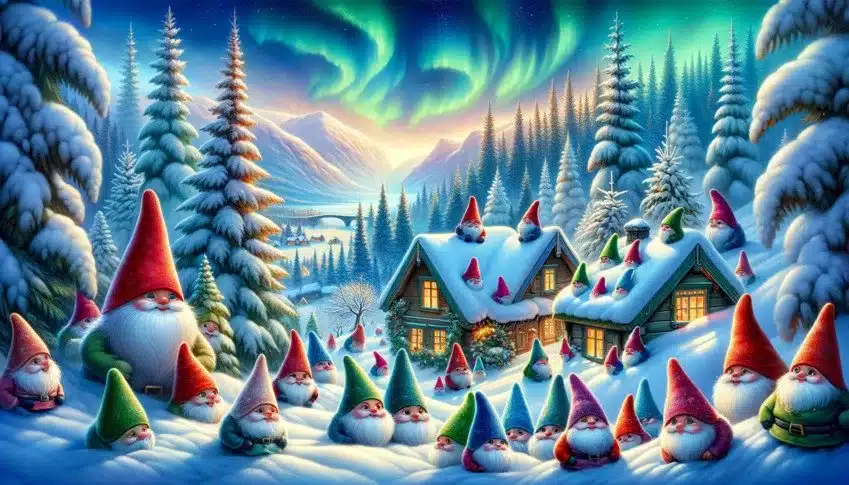
Picture this: a diminutive, gnome-like creature, bearded and often donning a tall, pointed hat that obscures its eyes. This is a gonk – a staple of Scandinavian folklore and a whimsical presence in homes around the globe, especially during the yuletide season. But what does this little figure, often nestled among holiday decor or peeking out from a bookshelf, really symbolize?
This isn’t just an article; it’s a heart-warming journey through the world of gonks, where we’ll explore not just their history and cultural significance, but what they mean to people like you and me. We’re diving headfirst into a world where folklore meets personal sentiment, where every gonk might just have a story to whisper.
So, come along, dear reader. Let’s embark on this whimsical adventure together, discovering the hidden depths of these charming creatures and maybe, just maybe, learning a little bit more about ourselves along the way.
Historical and Cultural Significance
Our journey begins in the snowy landscapes of Scandinavia, where the gonk first sprung to life – not just as a figure of myth, but as a symbol deeply entrenched in the culture. Originating from Nordic folklore, these creatures, also known as ‘tomte‘ in Sweden or ‘nisse‘ in Norway and Denmark, have long been considered guardians of the homestead, a bridge between the mystical and the mundane.
In the soft glow of a fireplace, with a cup of hot cocoa in hand, I sat down with Ingrid, a Swedish grandmother, whose eyes sparkled with the reflections of yuletide as she recounted tales passed down through generations. “The gonk,” she said in her melodious voice, “isn’t just a decoration. He’s a protector of our home, a keeper of our traditions. When the winter nights grow long, he watches over us.”
These guardians were believed to bring good fortune to those who treated them with respect and kindness – a bowl of porridge on a cold winter’s night, for instance. But their demeanor could quickly turn mischievous if they felt neglected or wronged. In these tales, the gonk’s role transcended that of a mere household spirit; it embodied the values of care, respect, and the deep, interconnected relationship between humans and the unseen world.
As I left Ingrid’s cozy living room, the warmth of her stories lingering in my heart, I realized that the gonk is more than a festive ornament. It’s a symbol of a culture’s connection to the mystical, a reminder of the unseen forces that, according to legend, play a quiet yet pivotal role in our lives. In our next section, we’ll explore how these ancient guardians have adapted to the modern world, finding new homes and new hearts to watch over.
Gonks in Modern Times
Fast forward from the ancient firesides of Scandinavia to the bustling streets of today’s cities. The gonk, once a mythical guardian of rural homesteads, has now found its way into the neon-lit windows of chic boutiques and cozy suburban homes. But what happens when an ancient symbol gets a modern makeover?
To find out, I ventured into the heart of the city, where gonks of all shapes and sizes now grace shop windows. Amidst the glittering displays, I met Jonas, a craftsman whose hands, as rugged as the pine forests of his homeland, were delicately fashioning a gonk from scraps of fabric and wood. “Each gonk,” he told me, his eyes twinkling with the joy of creation, “carries a piece of the old world into the new. They may be trendy now, but for me, they’re a way to keep our traditions alive.”
But it’s not just artisans like Jonas who are keeping the spirit of the gonk alive. As these figures have proliferated, their symbolism has evolved. No longer just protectors of the home, modern gonks have become emblems of comfort, whimsy, and a touch of magic in our often all-too-ordinary lives.
Personal Symbolism and Emotional Connections

Every gonk tells a story, and to uncover these tales, I sought out the keepers of these mystical creatures. In a cozy café, over steaming mugs of coffee and cinnamon buns, a group of gonk enthusiasts shared their personal connections with these charming figures.
For Emma, a young mother, her gonk is a reminder of her childhood, a link to the fairy tales her grandmother used to tell. “When I see my gonk sitting on the mantelpiece,” she said, her eyes aglow with nostalgia, “it’s like a part of my grandma is still here, watching over my kids.”
Then there’s Henrik, a burly man with a laugh as hearty as a roaring fire. His gonk, perched on his desk, serves as a talisman of sorts, a beacon of good luck and perseverance. “In the toughest times,” he confided, “a glance at that little fellow reminds me to keep smiling.”
As I listened to these stories, it became clear that the gonk is more than folklore; it’s a vessel for our deepest emotions and memories, a silent companion through the ups and downs of life.
The Gonk in Popular Culture
From the intimate corners of homes and hearts, the gonk has also danced its way into the broader tapestry of popular culture. To explore this phenomenon, I attended a local festival, where gonks took center stage in a parade of whimsy and joy.
There, amidst the laughter and music, gonks appeared in every conceivable form – from giant inflatable figures bobbing above the crowd to intricately crafted puppets in a children’s play. I spoke with a local author, whose children’s book about a brave little gonk had captured the imaginations of young and old alike. “Gonks remind us of the magic that’s still out there, waiting to be found,” she told me, her words echoing the sparkle in her eyes.
This excursion into the world of popular culture revealed how the gonk, once a humble guardian spirit, has become a cultural icon, a symbol of the enduring human love for stories and symbols that speak to our hearts.
In these modern renditions, the gonk continues to evolve, weaving its way through the fabric of our lives, reminding us of the enduring power of folklore and the timeless human need for connection and protection. In our next section, we’ll delve into the vibrant and often whimsical world of gonk collectors, where passion and nostalgia combine to keep the spirit of these enchanting creatures alive.
The Whimsical World of Gonk Collectors
Our journey through the world of gonks would be incomplete without a foray into the realm of those who cherish them most dearly: the collectors. In a quaint, fairy-light adorned hall, I found myself amidst the annual gathering of the National Gonk Enthusiasts Club.
Here, each collector had a tale as unique as their cherished gonks. I met Martha, whose sprawling collection began with a single gonk gifted by her late husband. Her eyes sparkled with memories as she showed me her oldest piece, a threadbare gonk with a crooked hat. “Every gonk in my collection,” she shared, “brings back a moment, a smile, a piece of my journey.”
Then there was young Liam, a bright-eyed boy of ten, whose fascination with gonks began with a storybook. His collection, though small, was curated with the precision of a true connoisseur. “Each one has a superpower,” he declared with the confidence of a seasoned collector, “like bravery, kindness, or making the best cookies!”
This colorful mosaic of collectors, each with their own story, revealed the gonk as more than a mere collectible. It’s a tapestry of memories and dreams, a symbol of the joys and sorrows that weave through our lives.
The Gonk’s Message in Today’s World
As my adventure neared its end, I reflected on the enduring appeal of the gonk in our fast-paced, often impersonal modern world. Amidst the hum of technology and the rush of daily life, these simple, whimsical creatures offer a respite, a reminder of the value of tradition, the warmth of home, and the power of imagination.
The gonk, with its understated charm, invites us to slow down, to cherish the little things, and to remember that sometimes, the most profound truths are found not in grand gestures, but in the quiet, unassuming corners of our lives.
Gonks Have Transcended Time and Culture
As I bid farewell to the world of gonks and the incredible people who cherish them, I am struck by the profound simplicity and depth these creatures embody. From their mythical origins in Scandinavian folklore to their modern-day incarnations in homes and hearts worldwide, gonks have transcended time and culture to become symbols of protection, comfort, and joy.
In a world often clouded by complexity, they remind us of the power of simplicity, the importance of tradition, and the enduring strength of the human spirit. The gonk, a humble guardian of the hearth, has become a guardian of our deepest values and memories, a silent witness to the stories that make us who we are.
So, dear reader, as you encounter these whimsical beings, whether perched on a shelf or nestled in a story, take a moment to ponder what they might symbolize for you. For in the end, the true magic of the gonk lies not just in its folklore or its form, but in the heart of the beholder.

